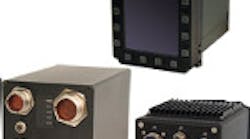VPX and PC/104: Coexisting to Support Different Military Applications
Parvus provides a range of rugged VPX and PC/104 platforms
In the world of military electronics, SWAP (size, weight and power) rules supreme. Unmanned and manned applications alike are often demanding the highest computational performance possible squeezed into highly dense, low-power solutions. There is growing demand for embedded subsystems capable of handling distributed multiprocessing architectures, serial switched fabrics, and enormous amounts of sensor I/O. These increasingly demanding technical requirements have sparked the development of numerous small form factor board architectures, including the meteorically rising VPX.
Aimed squarely at network-centric defense applications, VPX brings the performance of switched fabric interconnects such as PCI Express, Serial RapidIO and 10 Gigabit Ethernet into a rugged slot-card architecture familiar to legacy VME users. VPX affords SWAP advantages as users transition from VME to VPX’s high density, high bandwidth I/O and 3U form factor. Its conduction cooled formats also support blade-like, field replaceability (2 Level maintenance) with enhanced ESD/dust protection.
While the parallel VME bus architecture ranks in predominance in the military/aerospace market – thanks to its legacy installed base – VPX is poised to become the successor of traditional VME for a growing number of rugged applications. VPX may still be in its infancy; yet accordingly to industry estimates, it already claims more than 20% of the market previously served by VME. The rapid adoption of VPX is further accelerating due to the interoperability defined in the OpenVPX standard and the growing ecosystem of suppliers adopting it.
Different Boards for Different Applications
So while its ruggedness and performance capabilities point to VPX as the savior of military electronics, it is certainly not a catchall solution for every military application. In fact, for some, VPX systems may be overkill — too complex, too large, too expensive, or just too hot to handle. There are certainly tradeoffs. One size does not fit all.
For example, VPX uses more power and runs hotter than legacy buses like VME, PC/104 and CompactPCI. It is not uncommon for VPX cards to run at 100+ Watts per slot. VPX has plenty of power pins (enough to theoretically support up to 768W/slot) yet it presents a significant thermal management challenge to deal with this level of computational density. Sophisticated and highly effective cooling techniques, such as spray or liquid cooling are being implemented, yet this also adds to the complexity for system design and maintenance compared to passive cooling methods. Consequently, cost sensitive applications, those with lower computational needs and battery-powered systems may not be well suited for the VPX architecture.
PC/104 Serves Small Form Factor Niche
The benefits of VPX are numerous, yet it is still anticipated that other open architectures, including PC104 will continue to be deployed to meet differing budgetary and technical requirements. Gaining notable acceptance in the military arena this last decade, the PC/104 family has quickly proven it can address military requirements in mission computing, command and control (C2), force protection, intelligence surveillance and reconnaissance (ISR) and unmanned vehicle systems.
More than 100 vendors support the PC/104 standards with COTS boards and systems. The inherent benefits of PC/104, such as its rugged small form factor (akin to a 3.5” floppy disk), low power consumption (3W to 25W SBCs), and lego-like stackable modularity have earned PC/104 a secure position in many military programs. PC/104 typically foregoes the custom backplane common in VPX systems and can easily be configured to meet specific I/O requirements by mixing and matching boards that communicate over legacy ISA, PCI, and/or high-speed PCI-Express buses. PC/104 board mounting holes, small surface area, and rugged pin-and-socket stacking connectors lend themselves to good mechanical tolerance under shock and vibration. As evidenced by the growing number of pre-integrated PC/104-based rugged subsystems entering the market, PC/104 can take the heat, cold, altitude, shock or vibration dished at it.
However, with the proliferation of VPX, some suggest that PC/104 may soon become a thing of the past. Parvus contends that VPX and PC/104 can coexist as they serve unique needs for different military and aerospace applications. PC/104 fits the cost and size-conscious consumer, where single or dual-core processors suffice, and where power consumption is a major factor. For some applications, even 3U VPX will be too large. PC/104 is roughly 50% the board size. For some, a $100K VPX-based Line Replaceable Unit (LRU) may be not be an option. A $10K or $20K PC/104 subsystem may be. For some, an Intel Atom or Core2Duo processor provides sufficient processing throughput. Where multi-processor and/or high throughput serial switch fabric I/O requirements exist, VPX delivers strong with sophisticated thermal management schemes.
Future Still Bright for PC/104
Modernizing battlefield communications for network-centric warfare has created new board standards to expedite information. The creation of VPX has undoubtedly proved a valuable tool for many military applications, but other standards— such as PC/104— still play a critical role. With the addition of the PCI/104-Express standard, with its PCI-Express PCI ensures a long-term future for PC/104. PC/104 serves the low-to-mid market for military electronics quite well, whereas VPX will rein supreme in the higher end applications. The benefits and tradeoffs of these standards should not be overlooked as the military depends on these boards for mission critical applications and will continue to do so for years to come.
